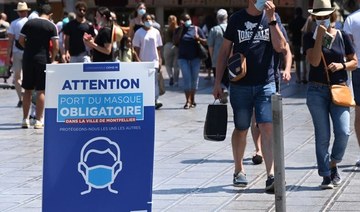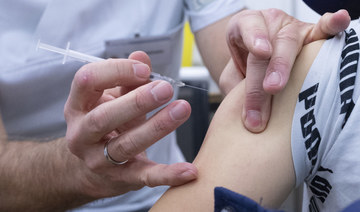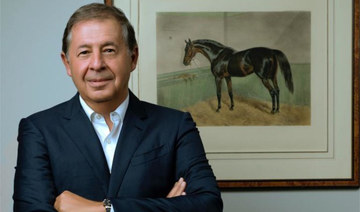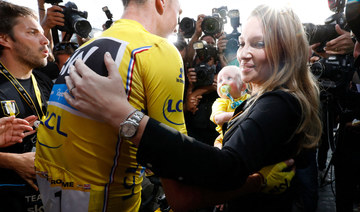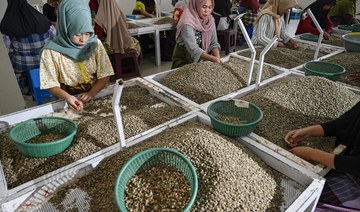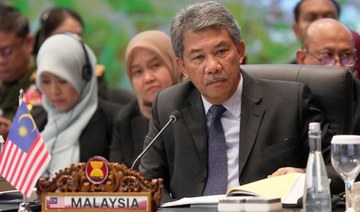BEIJING: Genetic material collected at a Chinese market near where the first human cases of COVID-19 were identified show raccoon dog DNA comingled with the virus, adding evidence to the theory that the virus originated from animals, not from a lab, international experts say.
“These data do not provide a definitive answer to how the pandemic began, but every piece of data is important to moving us closer to that answer,” World Health Organization Director-General Tedros Adhanom Ghebreyesus said Friday.
How the coronavirus emerged remains unclear. Many scientists believe it most likely jumped from animals to people, as many other viruses have in the past, at a wildlife market in Wuhan, China. But Wuhan is home to several labs involved in collecting and studying coronaviruses, fueling theories scientists say are plausible that the virus may have leaked from one.
The new findings do not settle the question, and they have not been formally reviewed by other experts or published in a peer-reviewed journal.
Tedros criticized China for not sharing the genetic information earlier, telling a press briefing that “this data could have and should have been shared three years ago.”
The samples were collected from surfaces at the Huanan seafood market in early 2020 in Wuhan, where the first human cases of COVID-19 were found in late 2019.
Tedros said the genetic sequences were recently uploaded to the world’s biggest public virus database by scientists at the Chinese Center for Disease Control and Prevention.
They were then removed, but not before a French biologist spotted the information by chance and shared it with a group of scientists based outside China that’s looking into the origins of the coronavirus.
The data show that some of the COVID-positive samples collected from a stall known to be involved in the wildlife trade also contained raccoon dog genes, indicating the animals may have been infected by the virus, according to the scientists. Their analysis was first reported in The Atlantic.
“There’s a good chance that the animals that deposited that DNA also deposited the virus,” said Stephen Goldstein, a virologist at the University of Utah who was involved in analyzing the data. “If you were to go and do environmental sampling in the aftermath of a zoonotic spillover event … this is basically exactly what you would expect to find.”
The canines, named for their raccoon-like faces, are often bred for their fur and sold for meat in animal markets across China.
Ray Yip, an epidemiologist and founding member of the US Centers for Disease Control office in China, said the findings are significant, even though they aren’t definitive.
“The market environmental sampling data published by China CDC is by far the strongest evidence to support animal origins,” Yip told the AP in an email. He was not connected to the new analysis.
WHO’s COVID-19 technical lead, Maria Van Kerkhove, cautioned that the analysis did not find the virus within any animal, nor did it find any hard evidence that any animals infected humans.
“What this does provide is clues to help us understand what may have happened,” she said. The international group also told WHO they found DNA from other animals as well as raccoon dogs in the samples from the seafood market, she added.
The coronavirus’ genetic code is strikingly similar to that of bat coronaviruses, and many scientists suspect COVID-19 jumped into humans either directly from a bat or via an intermediary animal like pangolins, ferrets or racoon dogs.
Efforts to determine the origins of the COVID-19 pandemic have been complicated by factors including the massive surge of human infections in the pandemic’s first two years and an increasingly bitter political dispute.
It took virus experts more than a dozen years to pinpoint the animal origin of SARS, a related virus.
Goldstein and his colleagues say their analysis is the first solid indication that there may have been wildlife infected with the coronavirus at the market. But it is also possible that humans brought the virus to the market and infected the raccoon dogs, or that infected humans simply happened to leave traces of the virus near the animals.
After scientists in the group contacted the China CDC, they say, the sequences were removed from the global virus database. Researchers are puzzled as to why data on the samples collected over three years ago wasn’t made public sooner. Tedros has pleaded with China to share more of its COVID-19 research data.
Gao Fu, the former head of the Chinese CDC and lead author of the Chinese paper, didn’t immediately respond to an Associated Press email requesting comment. But he told Science magazine the sequences are “nothing new. It had been known there was illegal animal dealing and this is why the market was immediately shut down.”
Goldstein said his group presented its findings this week to a WHO advisory panel investigating COVID-19’s origins.
Michael Imperiale of the University of Michigan, a microbiology and immunology expert who was not involved in the data analysis, said finding a sample with sequences from the virus and a raccoon dog “places the virus and the dog in very close proximity. But it doesn’t necessarily say that the dog was infected with the virus; it just says that they were in the same very small area.”
He said the bulk of the scientific evidence at this point supports a natural exposure at the market, and pointed to research published last summer showing the market was likely the early epicenter of the scourge and concluding that the virus spilled from animals into people two separate times. “What’s the chance that there were two different lab leaks?” he asked.
Mark Woolhouse, an infectious diseases expert at the University of Edinburgh, said it will be crucial to see how the raccoon dogs’ genetic sequences match up to what’s known about the historic evolution of the COVID-19 virus. If the dogs are shown to have COVID and those viruses prove to have earlier origins than the ones that infected people, “that’s probably as good evidence as we can expect to get that this was a spillover event in the market.”
After a weeks-long visit to China to study the pandemic’s origins, WHO released a report in 2021 concluding that COVID-19 most probably jumped into humans from animals, dismissing the possibility of a lab origin as “extremely unlikely.”
But the UN health agency backtracked the following year, saying “key pieces of data” were still missing. And Tedros has said all hypotheses remain on the table.
The China CDC scientists who previously analyzed the Huanan market samples published a paper as a preprint in February suggesting that humans brought the virus to the market, not animals, implying that the virus originated elsewhere. Their paper didn’t mention that animal genes were found in the samples that tested positive.
In February, the Wall Street Journal reported that the US Department of Energy had assessed “with low confidence” that the virus had leaked from a lab. But others in the US intelligence community disagree, believing it more likely it first came from animals.
Experts say the true origin of the pandemic may not be known for many years — if ever.
New COVID origins data point to raccoon dogs in China market
https://arab.news/yv9hm
New COVID origins data point to raccoon dogs in China market
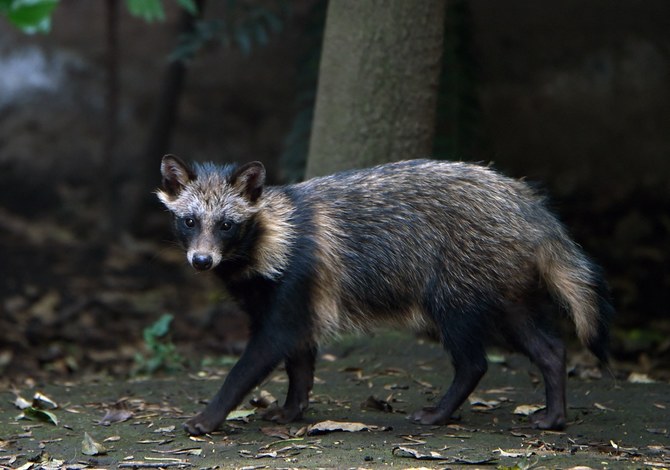
- The data show that some of the COVID-positive samples collected from a stall known to be involved in the wildlife trade also contained raccoon dog genes
Italy PM Meloni visits Tunisia for migration talks

- Tunisia is a major transit point for thousands of sub-Saharan migrants hoping to reach Europe every year
TUNIS: Italian Prime Minister Giorgia Meloni met with officials in Tunis Wednesday to discuss what she called a “new approach” to irregular migration and economic cooperation with Tunisia.
The hard-right leader’s visit, the fourth in less than a year to the north African country, came as her government pledged to curb irregular migrant arrivals in Italy.
Meloni met with President Kais Saied, who said after the meeting Tunisia must not become “a country of transit or settlement” for migrants from other African countries, according to a statement from his office.
In a video address released after her discussions with Saied, Meloni also said “Tunisia cannot be a country of arrival for migrants” from the rest of Africa.
She vowed to “involve international organizations to work on repatriations” of migrants while insisting on more European investment in African nations.
Ahead of the visit, an Italian official had told AFP that “cooperation on migration remains a central aspect of the relationship between Italy and Tunisia.”
“It remains essential that Tunisian authorities continue their action to combat human trafficking and contain illegal departures,” the official added.
Meloni’s latest visit to Tunisia came as part of her so-called Mattei Plan, a program aiming to posit Italy as a key bridge between Africa and Europe.
She said the fight against irregular migration required development for African countries and investments.
“Italy will continue to try to advance this new approach which it is promoting at a European level,” she said.
But critics say the plan would funnel energy north while exchanging investment in the south for deals aimed at curbing migration.
Three agreements were signed Wednesday: a 50-million-euro ($53-million) aid for energy projects, credit for small- and medium-sized businesses, and a university cooperation agreement.
Meloni also said Italy would encourage regular migration by granting 12,000 residence permits to Tunisians trained in specific fields.
Tunisia is a major transit point for thousands of sub-Saharan migrants hoping to reach Europe every year, with Italy as a frontline for their arrivals.
Almost 70,000 migrants were intercepted trying to cross the Mediterranean from Tunisia to Italy last year, according to Tunisian authorities.
Meloni visited Tunisia three times over the summer of 2023, twice with the European Commission chief Ursula von der Leyen.
The visits resulted in the European Union’s signing of an agreement in July to provide financial aid to debt-ridden Tunisia in return for its commitment to curb migrant departures.
The agreement provided 105 million euros to curb irregular migration — which the EU has started paying — added to 150 million euros in budgetary support.
European Parliament lawmakers criticized the agreement, citing a deterioration of human rights and freedoms in the north African country.
They also criticized Saied’s increasing authoritarian rule after his sweeping power grab in 2021.
Last month, the EU signed a similar deal with Egypt worth 7.4 billion euros on energy and migration.
Google employees arrested after protesting against $1bn contract with Israel
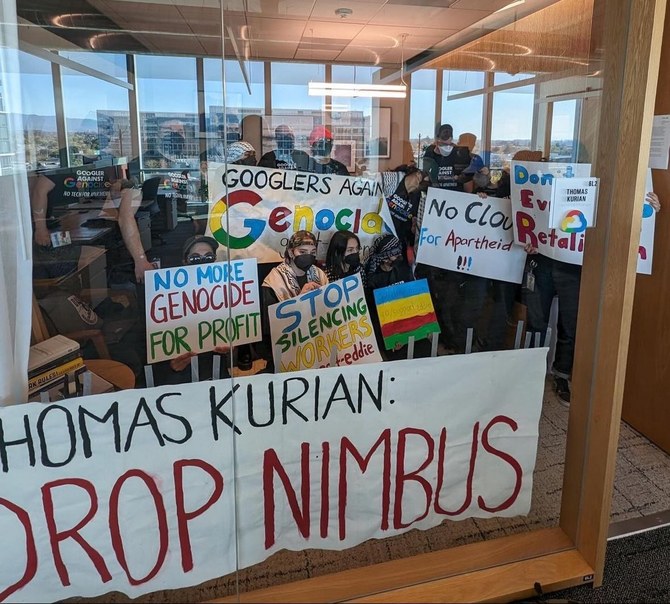
- 'Google workers do not want their labor to power Israel’s genocide of Palestinians in Gaza,' No Tech For Apartheid group said
LONDON: Several Google employees were arrested on Tuesday for taking part in a 10-hour sit-in at the company’s offices in New York and California.
The protest, organized by members of the No Tech For Apartheid movement, was meant as a challenge to the tech giant’s involvement with the Israeli government. It centered on a $1 billion cloud computing contract between Google, Amazon and the Israeli government and military, known as Project Nimbus.
The project involves creating a secure Google cloud setup in Israel to facilitate data analysis, AI training and other computing services, Time magazine reported.
According to leaked documents reported by American news organization Intercept in 2022, the project includes advanced features like AI-enabled facial detection and automated image categorization.
During the sit-in, a livestreamed video captured a security worker telling protesters at Google’s California office that they were on administrative leave and cautioned them about trespassing.
Social media videos showed police removing nine protesters from the premises. Similar actions were recorded at the company’s New York office.
A statement from the No Tech For Apartheid group said: “Google workers do not want their labor to power Israel’s genocide of Palestinians in Gaza. The time is now to rise up against Project Nimbus, in support of Palestinian liberation and join calls to end the Israeli occupation.”
Last month, a Google employee from the group interrupted a talk by the company’s Israel chief, accusing the company of “powering genocide.” He was later fired.
A Google spokesman told the Telegraph: “These protests were part of a longstanding campaign by a group of organizations and people who largely don’t work at Google. A small number of employee protesters entered and disrupted a couple of our locations.
“Physically impeding other employees’ work and preventing them from accessing our facilities is a clear violation of our policies and we will investigate and take action.
“These employees were put on administrative leave and their access to our systems was cut. After refusing multiple requests to leave the premises, law enforcement was engaged to remove them to ensure office safety.”
Man guilty of attacks near UK mosques given hospital order
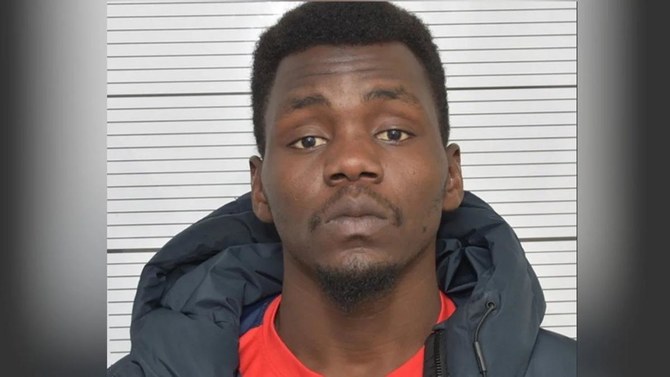
- Abbkr has paranoid schizophrenia and believed he was controlled by people possessed by evil spirits
LONDON: A man convicted of attempted murder after deliberately setting fire to two elderly men shortly after they left mosques in the UK was on Wednesday handed an indefinite hospital order.
Mohammed Abbkr, from Edgbaston in Birmingham, central England, deliberately set fire to Hashi Odowa, 82, and Mohammed Rayaz, 70, in February and March last year.
Abbkr, originally from Sudan, was convicted of two counts of attempted murder last year at Birmingham Crown Court in central England.
Judge Melbourne Inman told Abbkr, who has paranoid schizophrenia and believed he was controlled by people possessed by evil spirits: “You threw petrol over your victims and then set them alight — the attacks were horrific.”
“The two victims in this case were, on any rational view, chosen at random,” the judge told Abbkr, who watched the proceedings by video-link from Ashworth high security hospital in northwest England.
“You, however, genuinely believed each of them was one of those trying to take control of you.
“I am wholly satisfied that you committed both of these offenses at a time when you were suffering a severe mental illness.”
Abbkr sprayed petrol on the two men outside or near mosques they had attended and then set them alight. The attacks took place in west London on February 27 and Birmingham on March 20.
Odowa, who was attacked in London, was treated for severe burns to his face and arms. The Birmingham attack left Rayaz hospitalized with severe injuries.
70 killed as Afghanistan hit by heavy rains
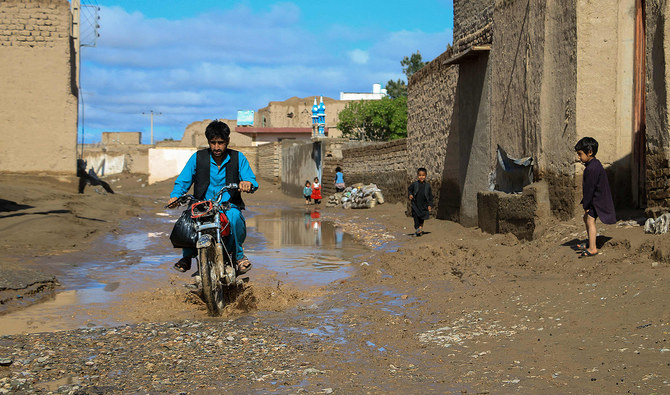
- Rains between Saturday and Wednesday triggered flash floods in most Afghanistan provinces
- Fifty-six people injured, over 2,600 houses have been damaged or destroyed, says Afghan official
KABUL: Around 70 people have been killed by heavy rains lashing Afghanistan over the past five days, the government’s disaster management department said Wednesday.
Afghanistan was parched by an unusually dry winter which desiccated the earth, exacerbating flash-flooding caused by spring downpours in most provinces.
Disaster management spokesman Janan Sayeq said “approximately 70 people lost their lives” as a result of rains between Saturday and Wednesday.
Fifty-six others have been injured, he said, while more than 2,600 houses have been damaged or destroyed and 95,000 acres of farmland wiped away.
Giving a smaller death toll last week, Sayeq said most fatalities at that point had been caused by roof collapses resulting from the deluges.
Neighbouring Pakistan has also been hammered by spring downpours, with 65 people killed in storm-related incidents as rain falls at nearly twice the historical average rate.
The United Nations last year warned that “Afghanistan is experiencing major swings in extreme weather conditions.”
After four decades of war the country ranks among the nations least prepared to face extreme weather events, which scientists say are becoming more frequent and severe due to climate change.
At least 25 people were killed in a landslide after massive snowfall in eastern Afghanistan in February, while around 60 were killed in a three-week spate of precipitation ending in March.
President Widodo urges Apple CEO to open manufacturing facility in Indonesia

- Country has ‘endless’ investment ability, Tim Cook says on visit to Jakarta
- Tech giant announces opening of new Apple Developer Academy in Bali
JAKARTA: Indonesian President Joko Widodo on Wednesday met the head of tech giant Apple and urged him to open a manufacturing facility in the country.
CEO Tim Cook was in Jakarta following a trip to Hanoi, where the company announced plans to increase spending on suppliers in Vietnam, its most important manufacturing hub outside China.
Before the meeting between Widodo and Cook, Apple announced plans to boost its investment in Indonesia and said it would open a new Apple Developer Academy — facilities designed to nurture local talent in the tech sector — in Bali, its fourth in the country.
“The meeting with Tim Cook focused on exploring strategic plans, including the opportunity of Apple expanding to Indonesia and further integration into the global supply chain,” Widodo said in a statement.
“I invited Apple to establish an innovation hub with potential universities in Indonesia for human resources development. I also urged Apple to develop a manufacturing facility in the country.”
Apple currently does not have a manufacturing facility in Indonesia but opened its first developer academy there in 2018.
The new facility takes the company’s total investment in Indonesia to 1.6 trillion rupiah ($98.4 million), according to Industry Minister Agus Gumiwang Kartasasmita.
“After this, the Ministry of Industry will conduct a business-matching program. We already have a list of the components (that Apple needs) and mobile components that are already produced in Indonesia, so perhaps there can be a partnership,” he said.
Apple has based much of its key manufacturing of iPads, Airpods and Apple Watches in Vietnam, and more recently India, as it explores ways to diversify its supply chains away from China.
Home to more than 270 million people, Indonesia has a young, tech-savvy population with more than 100 million people aged under 30.
According to figures from Statista, as of January, Apple had an 11.5 percent share of Indonesia’s mobile phone market, behind Oppo (18 percent) and Samsung (17 percent).
“We talked about the president’s desire to see manufacturing in the country and it’s something that we will look at,” Cook told reporters after meeting Widodo.
“I thought we had a great conversation and I really appreciated the time with him. It was a dialogue about how much potential there is in the country and our commitment to the country.”
Cook later met president-elect, Defense Minister Prabowo Subianto, who will take over from Widodo in October.
“I think the investment ability in Indonesia is endless, I think that there’s a lot of great places to invest and we’re investing,” Cook said. “We believe in the country.”



